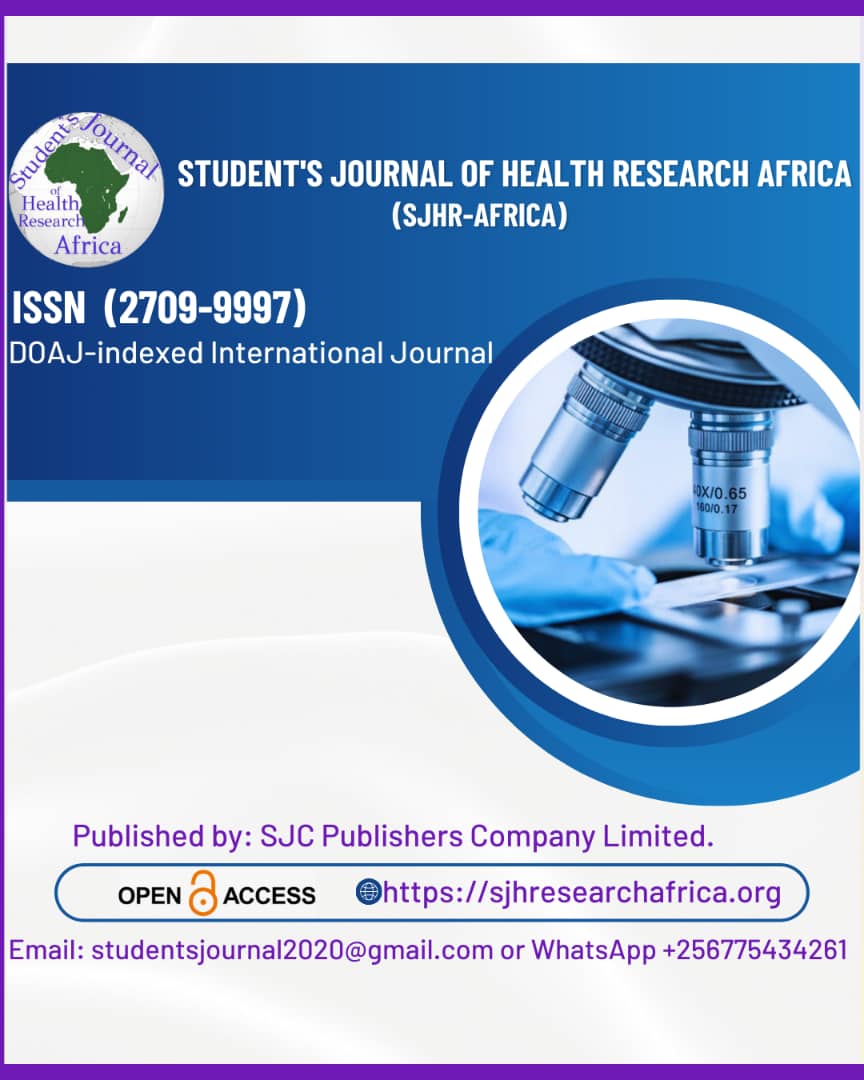Comparative analysis of partogram utility in monitoring labor progress among primigravida and multigravida women. A prospective observational study.
DOI:
https://doi.org/10.51168/sjhrafrica.v6i9.2085Keywords:
Partogram, primigravida, multigravida, labor progress, maternal outcome, neonatal outcomeAbstract
Background:
The partogram is a simple yet effective tool for monitoring labor, designed to detect deviations from normal progression and improve maternal and neonatal outcomes. Despite its proven benefits, routine utilization remains inconsistent in many low- and middle-income settings.
Objective:
To compare the effectiveness of partogram monitoring in primigravida and multigravida women by assessing labor progress, maternal interventions, and neonatal outcomes.
Methods:
Prospective observational study included 200 women (primigravida and multigravida) admitted in labor at a tertiary care hospital in West Bengal. Eligible participants were term singleton cephalic pregnancies in spontaneous or induced labor with cervical dilatation ≤7 cm. Exclusion criteria were multiple gestations, malpresentations, previous uterine surgery, and significant obstetric or medical complications. Labor progress was monitored using a standard partogram, and maternal, intrapartum, and neonatal outcomes were recorded and analyzed.
Results:
Primigravida women were significantly younger (23.8 ± 3.4 vs. 26.5 ± 3.9 years, p = 0.002), with a higher proportion of booked cases (72% vs. 65%, p = 0.18). The mean duration of the first stage of labor was longer in primigravida (7.07 ± 3.1 hrs) compared to multigravida (5.08 ± 3.1 hrs), and the second stage was also prolonged (30.3 ± 15.3 vs. 16.0 ± 15.1 min; both p < 0.05). Spontaneous vaginal delivery rates were higher in multigravida, while operative interventions were more common in primigravida. Neonatal outcomes were comparable, with no significant difference in Apgar scores (1-min: 7.5 ± 0.6 vs. 7.6 ± 0.5, p = 0.42; 5-min: 8.9 ± 0.4 vs. 9.0 ± 0.3, p = 0.35).
Conclusion:
Partogram use enabled early recognition of abnormal labor, improving intrapartum decision-making. Multigravida experienced shorter labor and fewer interventions.
Recommendations:
Routine partogram use should be emphasized, with closer monitoring of primigravida, regular staff training, integration into standard protocols, and further multicentric research to strengthen evidence.
References
Vallely LM, Calvert B, De Silva M, Panisi L, Babona D, Bolnga J, Duro-Aina T, Noovao-Hill A, Naidu S, Leisher S, Flenady V, Smith RM, Vogel JP, Homer CSE. Improving maternal and newborn health and reducing stillbirths in the Western Pacific Region - current situation and the way forward. Lancet Reg Health West Pac. 2022 Dec 13;32:100653. https://doi.org/10.1016/j.lanwpc.2022.100653
Gülmezoglu AM, Lawrie TA, Hezelgrave N, Vogel JP, Souza JP, Widmer M, et al. Interventions to reduce maternal and newborn morbidity and mortality. In: Black RE, Laxminarayan R, Temmerman M, Walker N, editors. Reproductive, maternal, newborn, and child health: disease control priorities. Washington (DC): The International Bank for Reconstruction and Development/The World Bank; 2016;3(2):115-136. https://doi.org/10.1596/978-1-4648-0348-2_ch7
Lavender T, Cuthbert A, Smyth RM. Effect of partograph use on outcomes for women in spontaneous labour at term and their babies. Cochrane Database Syst Rev. 2018;8(8): CD005461-7. https://doi.org/10.1002/14651858.CD005461.pub5
Sharma S, Parwez S, Batra K, Pareek B. Enhancing safe motherhood: Effect of novel partograph on labor outcomes and its utility: An Indian perspective. J Family Med Prim Care. 2022 ;11(11):7226-7232. https://doi.org/10.4103/jfmpc.jfmpc_1326_22
Hamilton EF, Romero R, Tarca AL, Warrick PA. The evolution of the labor curve and its implications for clinical practice: the relationship between cervical dilation, station, and time during labor. Am J Obstet Gynecol. 2023;228(5S):S1050-S1062. https://doi.org/10.1016/j.ajog.2022.12.005
Souza JP, Oladapo OT, Bohren MA, Mugerwa K, Fawole B, Moscovici L, Alves D, Perdona G, Oliveira-Ciabati L, Vogel JP, Tunçalp Ö, Zhang J, Hofmeyr J, Bahl R, Gülmezoglu AM; WHO BOLD Research Group. The development of a Simplified, Effective, Labour Monitoring-to-Action (SELMA) tool for Better Outcomes in Labour Difficulty (BOLD): study protocol. Reprod Health. 2015;12(2):49-54. https://doi.org/10.1186/s12978-015-0029-4
World Health Organization partograph in the management of labour. World Health Organization Maternal Health and Safe Motherhood Programme. Lancet. 1994 ;343(8910):1399-404. https://doi.org/10.1016/S0140-6736(94)92528-3
Lakshmidevi M, Malini KV, Shetty VH. Partographic analysis of spontaneous labour at term in primigravida. J Obstet Gynaecol India. 2012;62(6):635-40. https://doi.org/10.1007/s13224-012-0208-y
Bajpayee D, Sarin E, Chaudhuri S, Dastidar SG, Gupta A, Bisht N, Joshi A, Jeelani A, Rathi C, Parashar R, Verma G, Haldar K, Sridhar VS, Gupta S, Taneja G, Gera R. Strengthening the Use of Partograph in High Caseload Public Health Facilities in India through an Integrated Quality Improvement Approach. Indian J Community Med. 2020;45(4):487-491. https://doi.org/10.4103/ijcm.IJCM_530_19
Sowmya Krishna K, Paladi S. Comparative evaluation of labor progress and outcomes using partogram in primigravida and multigravida women. Int J Reprod Contracept Obstet Gynecol. 2023;12(5):1412-7.
Penumadu KM, Hariharan C. Role of partogram in the management of spontaneous labor in primigravidae and multigravidae. Int J Reprod Contracept Obstet Gynecol. 2014;3(4):1043-6. https://doi.org/10.5455/2320-1770.ijrcog20141233
Yadava A, et al. Partographic analysis of labor progression in primigravida and multigravida women at a tertiary care hospital, Ahmedabad. Int J Sci Res. 2022;11(8):21-4.
Thobbi VA, et al. Comparative study of maternal and perinatal outcomes in primigravida and multigravida using the WHO modified partograph. Int J Reprod Contracept Obstet Gynecol. 2021;10(3):992-7.
Friedman EA. Primigravid labor: A graphicostatistical analysis. Obstet Gynecol. 1955;6(6):567-89. https://doi.org/10.1097/00006250-195512000-00001
Philpott RH, Castle WM. Cervicographs in the management of labor in primigravidae. I. The alert line for detecting abnormal labor. J Obstet Gynaecol Br Commonw. 1972;79(7):592-8. https://doi.org/10.1111/j.1471-0528.1972.tb14207.x
Downloads
Published
How to Cite
Issue
Section
License
Copyright (c) 2025 Dr. Sonal Suryavanshi, Dr. Nidhi , Dr. Ujjwal Sourav

This work is licensed under a Creative Commons Attribution-NonCommercial-NoDerivatives 4.0 International License.





















